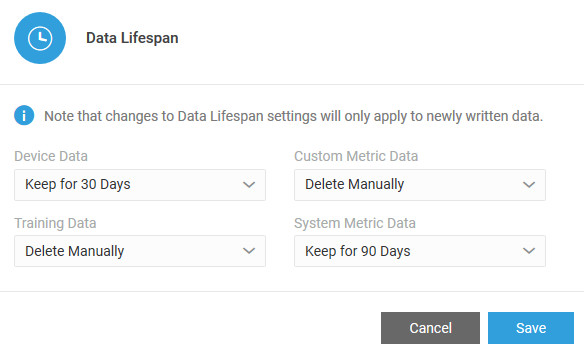15 Customize Your Application
Add a corporate logo or modify the application name to personalize your application. Use the Settings page in Oracle IoT Intelligent Applications Cloud Service to manage your application storage and capacity.
The data usage and capacity settings are shared between all the applications that you are using under Oracle IoT Intelligent Applications Cloud Service.
Show or Hide the Application Name
Show or hide the application name when business requirements change.
Add or Update an Application Logo
Add or update corporate logos when business requirements change or a new corporate logo is issued.
Set Default Units of Measure
Set the default units of measurement for your application. You can select between the US Imperial and Metric unit systems.
Change the Map Provider
You can change the map provider to replace Oracle maps with the maps provided by a third-party map provider. Currently, only maps provided by HERE Technologies are supported. When you change the map provider, the maps in the Oracle IoT Connected Worker Mobile Application are also updated.
Note:
To change the map provider, you must be an administrator. To review the Oracle maps terms of use, see Oracle Maps Cloud Service Enterprise Hosting and Delivery Policies.Monitor Data Storage and Manage Capacity Usage
As an administrator, you can monitor the data storage for your Oracle IoT Intelligent Applications Cloud Service. Use the Data Storage page to review storage data in the system, to set up or adjust the time window for data retention, and to run data deletion jobs.
Note:
If you are using more than one application in Oracle IoT Intelligent Applications Cloud Service, then the data storage settings are shared between these applications. Also, any operations that you perform under data management, such as tweaking data life spans or creating deletion jobs, affects data in all these applications.
So, for example, if you are using the Oracle IoT Asset Monitoring Cloud Service and Oracle IoT Production Monitoring Cloud Service applications, the data usage includes usage across both these applications. Also, if you were to delete metric data older than, say, 30 days, then metric data that is older than 30 days is deleted in both your applications.
When you log in to your IoT application as an administrator, a notification appears with details on the storage capacity used. Notifications may also appear periodically for every 10% of capacity that is used up. High-priority notifications are sent after you have used up more than half of the storage capacity. You can use the Data Storage page to manage your storage capacity.
- Summary: Shows you the total data storage capacity available for your account, and the currently used up capacity. Depending on your current usage, the status is indicated using one of the following colors:
- Green: Indicates that more than 50% of the available capacity remains.
- Orange: Indicates that between 25% and 50% of the available capacity remains. A recommendation on ways to manage your data is also included.
- Red: Indicates that less than 25% of the available capacity remains, and you must take steps to manage your storage data.

- Data Management: Lets you manage data, change settings, and create data deletion jobs. The data capacity usage percentages are shown category-wise:
- Device Data: Comprises application messages, connector messages, integration-related messages, log messages, and other related messages.
Device data is stored for 30 days, by default.
- Training Data: Comprises incoming sensor data, visualization and training data.
By default, training data is stored indefinitely in the system until manually deleted.
- Custom Metric Data: Comprises data specific to custom metrics or KPIs. Custom metrics are metrics that you create in the application for your production environment and scenarios.
By default, custom metric data is stored indefinitely in the system until manually deleted.
- System Metric Data: Comprises data specific to system metrics or KPIs. System metrics are the built-in metrics that are calculated automatically in your application.
System metric data is stored for 90 days, by default.
You can select the data life span for each category. The data life span is the time period for which data is retained.
You can choose to create data deletion jobs to delete selective data. A data deletion job lets you select the data type and time span for which you wish to delete data.
- Device Data: Comprises application messages, connector messages, integration-related messages, log messages, and other related messages.

